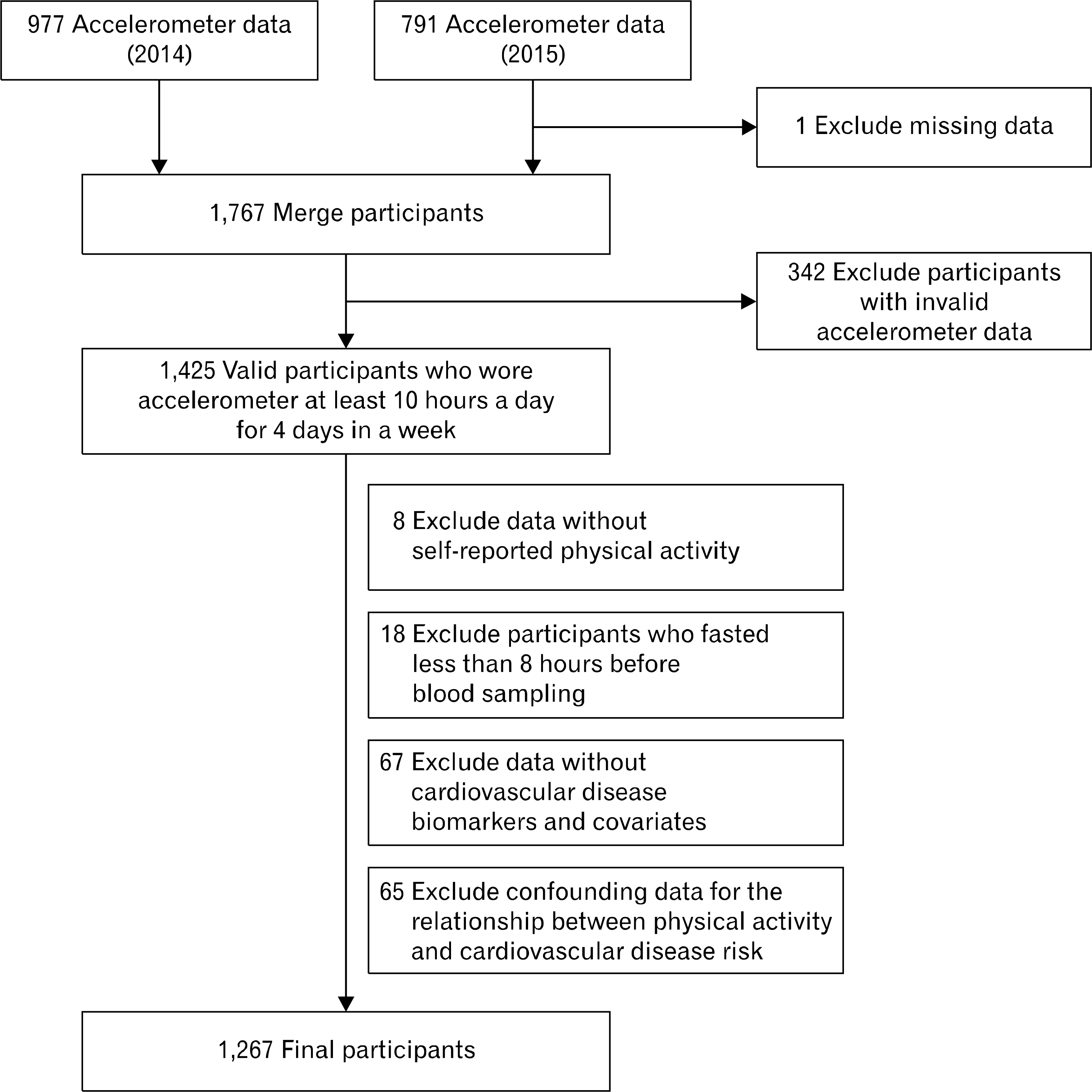Abstract
Purpose
Methods
Results
References
Table 1.
| Variable | Male | Female | ||
|---|---|---|---|---|
| No. (%) | Mean±SE | No. (%) | Mean±SE | |
| Age (yr) | ||||
| 19−29 | 72 (15.8)§ | 23.5±0.39 | 120 (14.8)§ | 24.3±0.30 |
| 30−39 | 92 (20.1)§ | 35.1±0.26 | 161 (19.9)§ | 35.4±0.22 |
| 40−49 | 108 (23.6)§ | 44.6±0.30 | 218 (26.9)§ | 44.9±0.19 |
| 50−59 | 128 (28.0)§ | 55.0±0.23 | 226 (27.9)§ | 54.6±0.19 |
| >60 | 57 (12.5)§ | 62.0±0.18 | 85 (10.5)§ | 62.1±0.16 |
| EDU | ||||
| <Elementary School | 32 (7.0)§ | 69 (8.5)§ | ||
| <Middle School | 41 (9.0)§ | 81 (10.0)§ | ||
| <High School | 178 (38.9)§ | 332 (41.0)§ | ||
| >Undergraduate | 206 (45.1)§ | 328 (40.5)§ | ||
| Alcohol∗ | ||||
| No | 130 (28.4)§ | 440 (54.3)§ | ||
| Yes | 327 (71.6)§ | 370 (45.7)§ | ||
| Smoking† | ||||
| No | 324 (70.9)§ | 780 (96.3)§ | ||
| Yes | 133 (29.1)§ | 30 (3.7)§ | ||
| BMI (kg/m2)‡ | ||||
| Underweight | 9 (2.0)§ | 17.8±0.22 | 45 (5.6)§ | 17.5±0.10 |
| Normal | 263 (57.5)§ | 22.7±0.10 | 556 (68.6)§ | 21.9±0.07 |
| Obese | 185 (40.5)§ | 27.5±0.17 | 209 (25.8)§ | 27.7±0.16 |
| CVD biomarker | ||||
| SBP (mm Hg) | 457 (36.1)∥ | 118.4±0.65 | 810 (63.9)∥ | 111.9±0.53 |
| DBP (mm Hg) | 457 (36.1)∥ | 78.5±0.48 | 810 (63.9)∥ | 72.8±0.32 |
| GLU (mg/dL) | 457 (36.1)∥ | 100.2±1.04 | 810 (63.9)∥ | 95.6±0.73 |
| HbA1c (%) | 457 (36.1)∥ | 5.7±0.04 | 810 (63.9)∥ | 5.6±0.02 |
| TC (mg/dL) | 457 (36.1)∥ | 188.9±1.58 | 810 (63.9)∥ | 189.6±1.20 |
| TG (mg/dL) | 457 (36.1)∥ | 138.6±3.44 | 810 (63.9)∥ | 103.4±2.16 |
| LDL (mg/dL) | 457 (36.1)∥ | 113.3±1.45 | 810 (63.9)∥ | 113.6±1.06 |
| HDL (mg/dL) | 457 (36.1)∥ | 48.0±0.53 | 810 (63.9)∥ | 55.3±0.43 |
SE: standard error, EDU: educational status (for example, <elementary school means that people up to elementary school graduated), BMI: body mass index, CVD: cardiovascular disease, SBP: systolic blood pressure, DBP: diastolic blood pressure, GLU: glucose, HbA1c: glycated hemoglobin, TC: total cholesterol, TG: triglyceride, LDL: low-density lipoprotein, HDL: high-density lipoprotein.
∗ No means that “have never been drunk alcohol before” or “less than one glass of alcohol consumed in a month in a recent year,” Yes means that “more than one glass of alcohol a month in a recent year”;
Table 2.
| Characteristics | n | Self-report MVPA∗ | Accelerometer MVPA∗ (total†) | Accelerometer MVPA∗ (10-min bouts‡) |
|---|---|---|---|---|
| Total | 1,267 | 364.32±16.76 | 211.36±4.67 | 93.18±3.62 |
| Sex | ||||
| Male | 457 | 474.64±36.28 | 247.15±8.78 | 104.07±6.82 |
| Female | 810 | 302.09±16.00 | 191.17±5.24 | 87.03±4.14 |
| Age (yr) | ||||
| 19−29 | 192 | 500.29±53.10 | 206.92±10.52 | 85.17±6.53 |
| 30−39 | 253 | 405.81±41.58 | 177.49±8.56 | 59.42±6.98 |
| 40−49 | 326 | 304.85±26.28 | 202.14±8.48 | 81.49±6.26 |
| 50−59 | 354 | 294.29±22.24 | 223.69±9.52 | 109.51±7.64 |
| >60 | 142 | 417.75±68.85 | 268.15±17.99 | 150.33±14.14 |
Table 3.
| CVD risk | PA tool | H-active | PA level∗ | P for trend | ||
|---|---|---|---|---|---|---|
| Active | I-active | Inactive† | ||||
| HTN (n=232)‡ | SR | Ref | 0.67 (0.49−0.92) | 1.06 (0.77−1.46) | 0.95 (0.69−1.30) | 0.844 |
| Pre-HTN (n=305)§ | A-total | Ref | 1.13 (0.83−1.53) | 1.35 (1.00−1.82)†† | 0.041 | |
| A-bout | Ref | 1.31 (0.79−2.19) | 1.56 (0.98−2.46) | 1.67 (1.02−2.76)†† | 0.034 | |
| DM (n=96)∥ | SR | Ref | 0.74 (0.39−1.35) | 0.83 (0.45−1.47) | 0.79 (0.43−1.39) | 0.430 |
| A-total | Ref | 1.12 (0.61−2.09) | 1.77 (1.01−3.19)†† | 0.032 | ||
| A-bout | Ref | 0.85 (0.33−2.30) | 1.47 (0.68−3.53) | 1.32 (0.55−3.43) | 0.252 | |
| DLP (n=528)¶ | SR | Ref | 1.25 (0.87−1.80) | 0.97 (0.67−1.41) | 1.11 (0.78−1.59) | 0.775 |
| A-total | Ref | 1.05 (0.73−1.51) | 1.65 (1.17−2.36)†† | 0.002 | ||
| A-bout | Ref | 1.08 (0.59−2.02) | 1.14 (0.67−2.01) | 1.75 (0.98−3.18) | 0.018 | |
| OBE (n=394)∗∗ | SR | Ref | 1.05 (0.75−1.48) | 0.99 (0.71−1.39) | 0.95 (0.68−1.33) | 0.758 |
| A-total | Ref | 1.01 (0.72, 1.41) | 1.10 (0.79−1.52) | 0.533 | ||
| A-bout | Ref | 1.17 (0.66, 2.11) | 1.17 (0.70−2.00) | 1.24 (0.71−2.20) | 0.503 | |
CVD: cardiovascular disease, PA: physical activity, H-Active: highly active, I-Active: insufficiently active, HTN: hypertension, SR: self-report, Ref: reference, A-total: accelerometer in total minutes, A-bout: accelerometer in 10-min bouts, DM: diabetes mellitus, DLP: dyslipidemia, OBE: obesity.
∗ Odds of being included in CVD risk group compared to highly active as the reference group of PA level (in HTN, odds ratio means that odds of being included in pre-HTN or HTN group);
† No participants when MVPA was considered from A-total covariates: sex, age, alcohol, smoking, educational status;




 PDF
PDF ePub
ePub Citation
Citation Print
Print



 XML Download
XML Download